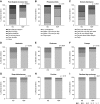Effects of Hemodiafiltration versus Conventional Hemodialysis in Children with ESKD: The HDF, Heart and Height Study
- PMID: 30846560
- PMCID: PMC6442347
- DOI: 10.1681/ASN.2018100990
Effects of Hemodiafiltration versus Conventional Hemodialysis in Children with ESKD: The HDF, Heart and Height Study
Abstract
Background: Hypertension and cardiovascular disease are common in children undergoing dialysis. Studies suggest that hemodiafiltration (HDF) may reduce cardiovascular mortality in adults, but data for children are scarce.
Methods: The HDF, Heart and Height study is a nonrandomized observational study comparing outcomes on conventional hemodialysis (HD) versus postdilution online HDF in children. Primary outcome measures were annualized changes in carotid intima-media thickness (cIMT) SD score and height SD score.
Results: We enrolled 190 children from 28 centers; 78 on HD and 55 on HDF completed 1-year follow-up. The groups were comparable for age, dialysis vintage, access type, dialysis frequency, blood flow, and residual renal function. At 1 year, cIMT SD score increased significantly in children on HD but remained static in the HDF cohort. On propensity score analysis, HD was associated with a +0.47 higher annualized cIMT SD score compared with HDF. Height SD score increased in HDF but remained static in HD. Mean arterial pressure SD score increased with HD only. Factors associated with higher cIMT and mean arterial pressure SD-scores were HD group, higher ultrafiltration rate, and higher β2-microglobulin. The HDF cohort had lower β2-microglobulin, parathyroid hormone, and high-sensitivity C-reactive protein at 1 year; fewer headaches, dizziness, or cramps; and shorter postdialysis recovery time.
Conclusions: HDF is associated with a lack of progression in vascular measures versus progression with HD, as well as an increase in height not seen in the HD cohort. Patient-related outcomes improved among children on HDF correlating with improved BP control and clearances. Confirmation through randomized trials is required.
Keywords: cardiovascular disease; carotid intima-media thickness; children; growth; hemodiafiltration (HDF); hemodialysis.
Copyright © 2019 by the American Society of Nephrology.
Figures







References
-
- Shroff R, Long DA, Shanahan C: Mechanistic insights into vascular calcification in CKD. J Am Soc Nephrol 24: 179–189, 2013 - PubMed
-
- Civilibal M, Caliskan S, Oflaz H, Sever L, Candan C, Canpolat N, et al. .: Traditional and “new” cardiovascular risk markers and factors in pediatric dialysis patients. Pediatr Nephrol 22: 1021–1029, 2007 - PubMed
Publication types
MeSH terms
Substances
LinkOut - more resources
Full Text Sources
Medical
Research Materials

